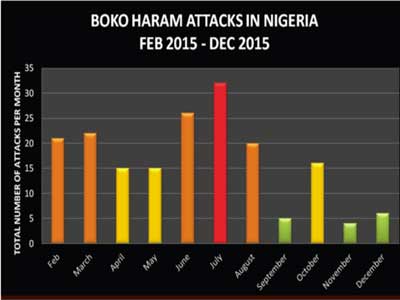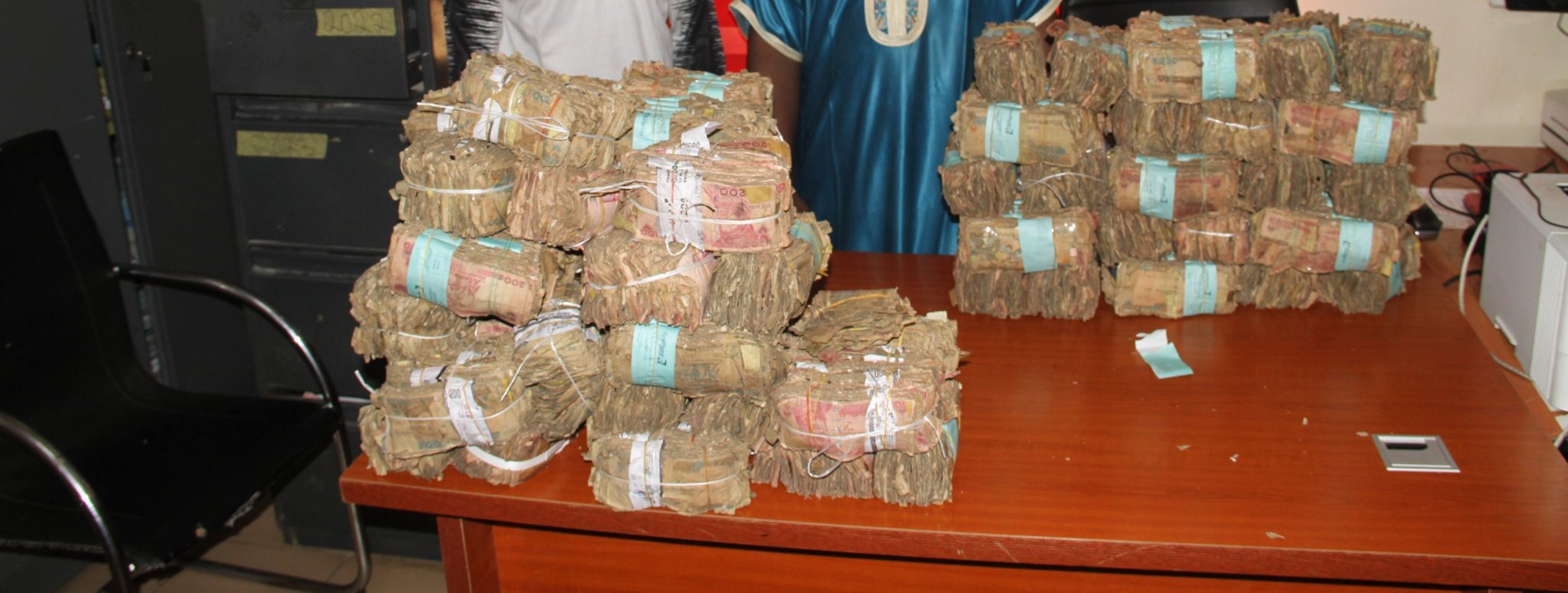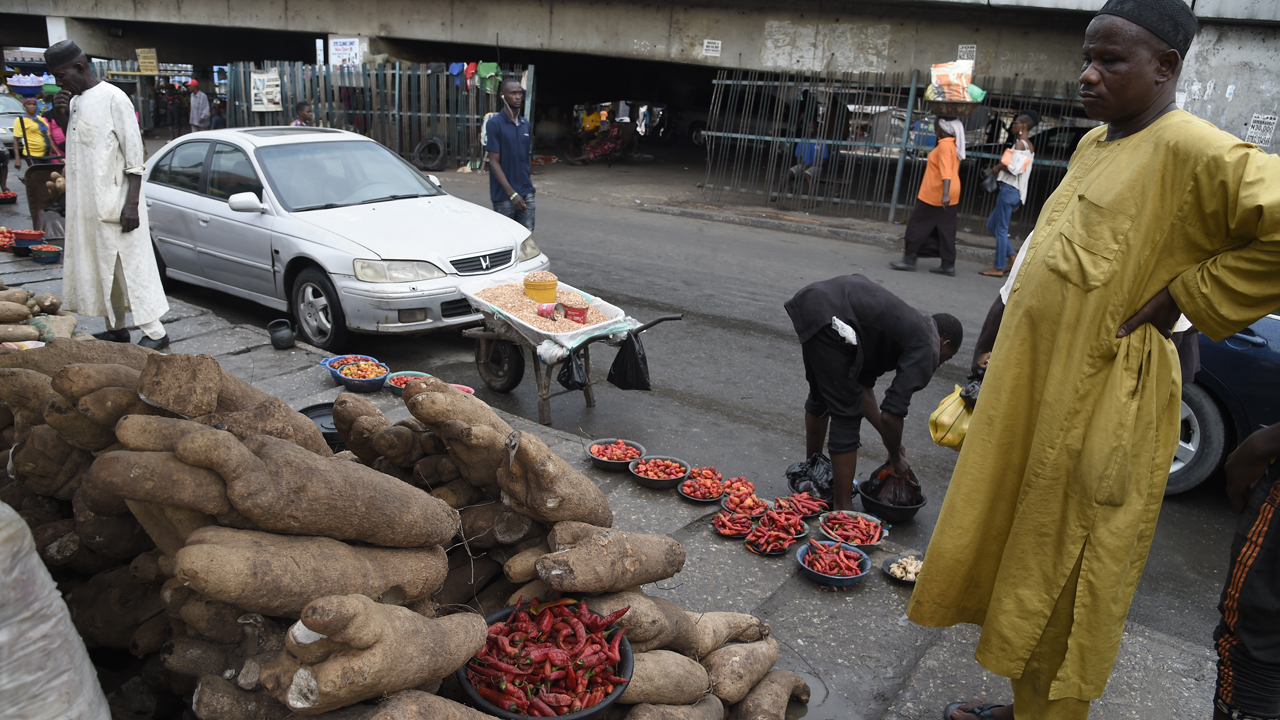
This graph reveals a few points: First, it confirms the significant increase in Boko Haram attacks after the Presidential inauguration in May. This increase could be attributed to several things including the fact that perhaps both the military and Boko Haram insurgents were in full war mode.
Second, it shows a noticeable drop in the frequency of Boko Haram attacks towards the end of 2015. The noticeable drop in attacks does not mean that the terrorists have been defeated. In fact, throughout the year, a reduction in attacks was typically followed by a significant increase in attacks. This gave indications that the insurgents took time off to re-group, increase their IED stockpile, re-strategized on their next targets and tactics, and carried out more successful attacks.
The last quarter reduction in Boko Haram attacks could be the insurgents retreating to restock and prepare for new waves of attacks. Or it may be as a result of the effective military campaign under the new administration and military leadership. This cannot be fully ascertained until the levels of attacks continue to remain low throughout 2016.
The intelligence war has not yet been won
There is still more work to be done as sporadic gunmen and IED attacks still occurs, while the Chibok girls are still nowhere to be found. These aforementioned ongoing issues point to the need for the government to enhance its intelligence capabilities, and strengthen its counter-IED strategies.
An effective intelligence strategy during these times of decreased Boko Haram attacks will help prevent the insurgent resurgence trend. Intelligence agencies should intensify their efforts in identifying the means of communication, safe havens and supply routes of the insurgents.
Government and public response/reaction to IED threats
Nigerians have already begun adapting to the new normal. Places of worship, concert halls, hotels, shopping malls and other “soft targets” have started taking measures to make themselves less attractive to would-be bombers. If you are going to a large gathering and no one is carrying out security checks at the entrance, you may want to rethink going in, or hasten your stay there. The government should encourage effective communication of IED detection tips and safety procedures to members of the public as well as private security companies and their operatives across the country.
When it comes to the IED experts, there needs to be an adequate number of Explosive Ordinance Disposal (EOD) Units as well as the IED exploitation forensics specialists deployed across the country. Personnel within these units should be well trained on how to safely disengage and dismantle an active IED and carefully gather up the components for further forensics. Effective IED forensics can help identify what components are being used to make the explosive device, and the responsible security agencies can then adopt known methods of tracking to trace the flow of IED making components and disrupt them.
Just as the use of color dye can be used in tracking or tracing the flow of liquid when there is a leak; Or float tracing method can be used to determine the flow of water by throwing an object into the water in order to see where it goes or emerges. A similar method can be used in countering the flow of IED components in the market. Controlled dud components can be put into the supply chain of the insurgent’s area of operation and once any of these components are used in making the IED, the IEDs will not detonate. But intelligence experts will understand where the components were gotten from and take the appropriate measures in apprehending all parties involved.
Remote controlled IEDs
There were news reports quoting a government official as saying that girls carrying IEDs for suicide bombings were unaware of their missions. The report stated that the girls were given the bombs in the form of a parcel and were instructed to go to a busy place, and upon getting there, the bombs were remotely detonated by an insurgent lurking around the corner waiting for an opportune moment.
While some security experts and non-experts alike may beg to differ on this information, the key take away here is that remote controlled IEDs are being used, which means jamming equipments may be utilized to help prevent such IEDs from detonating in crowded areas. Secondly, it means that first responders, security operatives and even members of the public should be on the lookout for and or report suspicious personnel after a blast incident, if possible.
Bomb making experts and the network
There were news reports about Nigerian Army troops arresting several Boko Haram IED making experts in Maiduguri and also in Kaduna State. No counter IED strategy will be successful without the deliberate targeting of those involved in the IED network. Priority must be given to the IED making experts, and when they are apprehended as much information must be extracted from them but more importantly, this information must be shared with intelligence analysts as this will fill information voids.
The military has been doing really well in sharing information with members of the public based on intelligence they receive on Boko Haram bombing tactics. There were warnings given about Boko Haram tactics of luring innocent civilians together with money and then subsequently carrying out attacks on the crowd. There was the warning of Boko Haram plans to use beggars to carry out attacks, and also plans to conceal explosives in bundles of firewood placed unsuspectingly around Maiduguri. They also gave warnings of the terrorists’ plans to shout Boko Haram in order to create panic and detonate their bombs during the pandemonium.
So has Boko Haram been technically defeated?
The Federal Government and military appear to be working hard to ensure this insurgency is ended once and for all. Their renewed commitment has led to a reduction in Boko Haram attacks in Nigeria. Progress has been made, but the Boko Haram has not yet been defeated.
Members of the public are still being warned about possible Boko Haram attacks. There is still no credible intelligence on the whereabouts of the Chibok girls that were kidnapped by Boko Haram insurgents. There are still bombing attacks taking place, insurgents are still being apprehended in states outside of their typical areas of operations. There is clearly still a lot more work to be done.
Email: tanwa.ashiru@bulwarkintelligence.com
Website: www.bulwarkintelligence.com
Twitter: @bulwark_intel
















